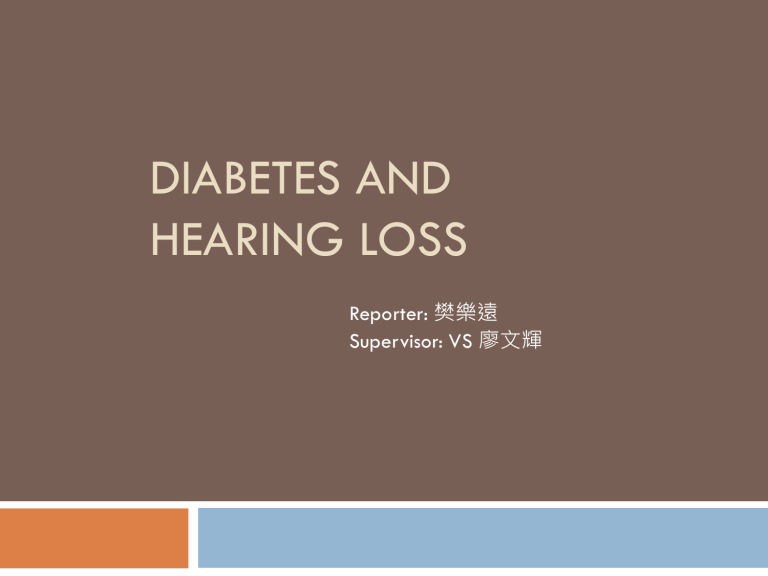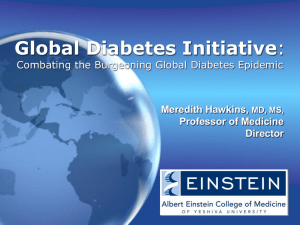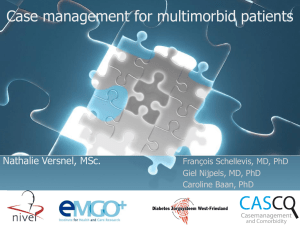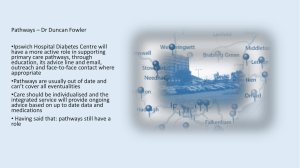Diabetes and hearing loss

DIABETES AND
HEARING LOSS
Reporter: 樊樂遠
Supervisor: VS 廖文輝
Diabetes complication
Cardiovascular disease : stroke or a fatal cardiac event is two to four times higher
Diabetic retinopathy : leading cause of blindness in the
United States
Renopathy: leading cause of kidney failure.
Nerve disease: major cause of lower extremity amputations.
Diabetic autonomic neuropathies: can affect cardiovascular, gastrointestinal, bladder, and erectile function.
According to the American Diabetes Association, nearly 26 million people in the U.S. have diabetes, and another 34.5 million have some degree of hearing loss.
Etiology
Small blood vessels and nerves in the inner ear.
High blood glucose levels can damage these vessels and nerves, diminishing the ability to hear.
Histopathological evidence
Vascular or neurological involvement obtained from autopsied patients with diabetes
sclerosis of the internal auditory artery
thicker vessel walls of the stria vascularis
demyelination of the cochlear nerve
atrophy of the spiral ganglion.
Makishima, K., & Tanaka, K. (1971). Pathological changes of the inner ear and central auditory pathway in diabetics. Annals of Otology, Rhinology &
Laryngology, 80, 218 –228.
Loss of outer hair cells has also been observed among patients with diabetes.
Fukushima, H., Cureoglu, S., Schachern, P., Paparella,
M., Harada, T., & Oktay, M. (2006). Effects of type 2 diabetes mellitus on cochlear structure in humans.
Archives of Otolaryngology —Head & Neck Surgery,
132, 934 –938.
http://en.wikipedia.org/wiki/Stria_vascularis
_of_cochlear_duct
Fukushima, H., Cureoglu, S., Schachern, P., Paparella,
M., Harada, T., & Oktay, M. (2006). Effects of type 2 diabetes mellitus on cochlear structure in humans.
Archives of Otolaryngology —Head & Neck Surgery,
132, 934 –938.
Fukushima, H., Cureoglu, S., Schachern, P., Paparella,
M., Harada, T., & Oktay, M. (2006). Effects of type 2 diabetes mellitus on cochlear structure in humans.
Archives of Otolaryngology —Head & Neck Surgery,
132, 934 –938.
Review
Researchers in the Framingham cohort study
averaged pure-tone air conduction thresholds above 250, 500, and 1000 Hz as well as 4000,
6000, and 8000 Hz in the better ear and worse ear
they defined hearing impairment as a pure-tone average > 40 dB HL
no association with diabetes
Gates, G., Cobb, J., D'Agostino, R., & Wolf, P.
(1993). The relation of hearing in the elderly to the presence of cardiovascular disease and cardiovascular risk factors. Archives of
Otolaryngology
—Head & Neck Surgery, 119,
156 –161.
Hispanic Health and Nutrition Examination Study, examined pure-tone air conduction thresholds at
500, 1000, 2000, and 4000 Hz by diabetes status
higher threshold among diabetic persons only at a single frequency (500 Hz)
Ma, F., Gomez-Marin, O., Lee, D., & Balkany, T.
(1998). Diabetes and hearing impairment in
Mexican American adults: A population-based study. The Journal of Laryngology and Otology,
112, 835 –839.
Epidemiology of Hearing Loss Study, a communitybased investigation conducted in Beaver Dam,
Wisconsin
defined impairment as the pure-tone average above 500, 1000, 2000, and 4000 Hz > 25 dB HL in the worse ear
a modestly increased occurrence of hearing impairment among adults with diabetes compared to those without diabetes
Dalton, D., Cruickshanks, K., Klein, R., Klein, B.,
& Wiley, T. (1998). Association of NIDDM and hearing loss. Diabetes Care, 21, 1540 –1544.
National Health and Nutrition Examination Study
investigators evaluated hearing impairment using high-frequency (3000-, 4000-, 6000-, and 8000-
Hz) as well as low- or middle-frequency (500-,
1000-, and 2000-Hz)
at two levels of severity ( >25 and >40 dB HL )
in both the worse and better ear
Bainbridge, K., Hoffman, H., & Cowie, C. (2008).
Diabetes and hearing impairment in the United
States: Audiometric evidence from the National
Health and Nutrition Examination Survey, 1999 to 2004. Annals of Internal Med icine , 149, 1
–10.
The prevalence of hearing impairment depends on how the condition is defined
a greater prevalence of hearing impairment was observed among adults with diagnosed diabetes than without, regardless of the definition used.
http://www.asha.org/aud/articles/diabeteshearing-impairment/
http://www.asha.org/aud/articles/diabeteshearing-impairment/
http://www.asha.org/aud/articles/diabeteshearing-impairment/
Persons with diabetes may experience hearing loss at earlier ages .
In the younger group, people with diabetes had a
2.6 times higher likelihood of impaired hearing.
Audiologists seeing middle-aged patients with unexplained hearing loss may wish to inquire about history of diabetes and family history of diabetes .
Patients with diabetes should be encouraged in their efforts to maintain good blood glucose control in accordance with guidelines from the American
Diabetes Association (2010).
The study included more than 5,100 adults who had hearing tests performed as part of a large nationwide health study in the United States.
People with diabetes were much more likely to have hearing loss than those without diabetes.
Diabetes and hearing impairment in the United States: audiometric evidence from the National Health and
Nutrition Examination Survey, 1999 to 2004, by
Kathleen E. Bainbridge and colleagues. Annals of
Internal Medicine 149:1-10, 2008
The higher risk of hearing loss in people with diabetes did not seem to be related to other common causes of hearing loss.
younger diabetics were at even higher risk than older adults, though they could not explain why.
Type 1 or type 2 DM?
In 2008, researchers from the U.S. National
Institutes of Health (NIH) saw similar patterns in a sample of more than 11,000 people , with people with diabetes twice as likely to have hearing loss as those without.
Another limit of the analysis, Zonszein said, is that many studies did not differentiate between people with type 1 and type 2 diabetes.
Type 2 diabetes , which often is related to aging and obesity , is far more common than type 1 , which is an immune-system disease that usually arises at a young age .
Data were obtained from 13 eligible studies
(20,194 participants).
Overall pooled OR (95% confidence interval) of hearing impairment for diabetic participants compared with nondiabetic participants was 2.15
(1.72–2.68).
Horikawa's team found that diabetics were 2.15 times as likely as people without the disease to have hearing loss.
But when the results were broken down by age, people under 60 had 2.61 times the risk while people over 60 hand 1.58 times higher risk.
The strength of the association between diabetes and
prevalence of hearing impairment was not significantly influenced by whether participants were matched for gender (P =0.68) or whether participants chronically exposed to noisy environments
were excluded (P = 0.19).
Conclusions
Current meta-analysis suggests that the higher prevalence of hearing impairment in diabetic patients compared with nondiabetic patients was consistent regardless of age.
Better sugar control?
No one knows yet whether gaining better control over your blood sugar will curb any risk of hearing loss.
Women between the ages of 60 and 75 with wellcontrolled diabetes had better hearing than women with poorly controlled diabetes, with similar hearing levels to those of non-diabetic women of the same age.
The study also shows significantly worse hearing in all women younger than 60 with diabetes, even if it is well controlled.
Dr. Handzo, Henry Ford study authors are
Virginia S. Ramachandran, Au.D.; Brad A.
Stach, Ph.D.; Ed S. Peterson, Ph.D.; and
Kathleen L. Yaremchuk, M.D.
Diabetes Affects Hearing Loss, Especially in Women. Jan. 26, 2012
Men , however, had worse hearing loss across the board compared to women in the study, regardless of their age or whether or not they had diabetes.
“Our study really points to importance of patients controlling their diabetes, especially as they age, based on the impact it may have on hearing loss.”
http://visual.ly/diabetesalert-day-2012-connectionbetween-diabetes-andhearing-loss
Thank you for your attention!
http://thecookiebitechronicles.wordpress.com/tag/pimpyour-nhs-hearing-aid/
http://www.trendhunter.com/trends/hearing-aid-bling http://cutcaster.com/photo/800939532-Hearing-Aid/






